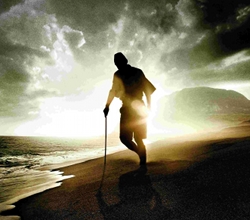Top Ten: Italian Films
Next on our cinematic itinerary is Italy, home of Cinecittà, neorealism, spaghetti westerns, giallo, and sword-and-sandal epics. The story of Italian cinema conjures worlds of pictorial beauty, emotionalism (whether heightened or repressed), a sometimes bitter engagement with history, and transformations of various genres into peculiarly Italian idioms. Like any national cinema, it has its peaks and valleys, but Italian films still make dents on the international scene, although not with the force or frequency of its heyday in the middle of the 20th century. This week’s Top Ten Tuesday celebrates our Top Ten Italian Films!
>> Readers’ Selections
1. Life Is Beautiful (1997)
2. 8½ (1963)
3. Umberto D. (1952)
4. Rome, Open City (1945)
5. The Gospel According to Matthew (1964)
6. La Strada (1954)
7. The Battle of Algiers (1966)
8. Germany Year Zero (1948)
9. The Conformist (1970)
10. Once Upon a Time in the West (1968)
>> Adam’s Selections
10. Miracle in Milan (1951)
An unruly comic fable from neorealist pioneers Vittorio De Sica and Cesare Zavattini, Miracle in Milan revisits the milieus of their earlier Bicycle Thief and Shoeshine but instead played up the greed and gluttony possible from both the capitalist and the downtrodden. Francesco Golisano is the optimistic all-around good guy Totò, raised by a virtuous old woman who found him in her cabbage patch and becomes the ward of an orphanage upon her death. Now eighteen and on his own, he eventually makes his way to a town of squatters near Milan and helps them set up a community. From there, two miracles occur: drilling for water actually uncovers oil, bringing in a tycoon and his business muscle; and Totò’s ghostly fairy godmother delivers him a white dove with the power to grant the wishes of the poor folk. What they wish for is De Sica’s and Zavattini’s most scathing rebuke to humanity’s insatiable materialism, done with a wink towards the lower classes so generously honored in the pair’s previous collaborations.
9. The Icicle Thief (1989)
Although it may seem perverse to include on my list a sweetly satiric take off on The Bicycle Thief but not the genuine article itself, I hope I can adequately defend Maurizio Nichetti’s one-of-a-kind comedy. Three worlds converge across the television medium: a neorealist homage directed and introduced by Nichetti’s on-screen counterpart for a TV program; the crass, glitzy commercials that interrupt the film at regular intervals; and a contemporary family sitting down to watch. When a power failure hits the TV station airing the program, a model from a commercial magically appears within the black-and-white film, and things get even more intermingled from there. The Icicle Thief has a lot to say about television’s degradation of the movies by commercial breaks and unnecessary cuts, narrative discontinuities that modern audiences (like the family viewing at home) have all but incorporated into their habits. But most importantly, Nichetti has immense fun playing the gaudy commercials against the abject neorealism, pointing up how they feed one another in the business of movie-making.
8. China is Near (1967)
Few Italian filmmakers are as in tune with the historical and political trends of their time as Marco Bellocchio. His second feature, China is Near, is a bleakly funny satire of competing classes and the subtle infighting within a kind of extended family. So many plot threads converge around two brothers, their sister, and their two servants, an accountant and a secretary: the eldest brother, a professor, is running for local office as a Socialist; his brother is a young, sneering Communist; their sister projects an upper-crust confidence that she can’t actually sustain; and the two servants have schemed to become romantically entangled with the older brother and sister to get their hands on the class privilege. Bellocchio shoots all of this intrigue with grace and fluidity, and the film has many moments of politically-aware laugh-out-loud comedy. In playing each hypocritical, presumptuous side against the others, Bellocchio examines the bitter truth: that the outside is as beautiful as the inside is rancid.
7. The Great War (1959)
A deeply ironic mixing of Buck Privates and Paths of Glory, The Great War is Mario Monicelli’s steely-eyed look at the Italian infantry of World War I. Roguish Vittorio Gassman and hapless Alberto Sordi are united in shiftlessness from basic training through battle with lulls of leave in between. Slapstick vies with pathos as these common men bumble their way through the war, attempting to stay sane and find a little pleasure in the midst of dour circumstances. Monicelli shoots battle scenes with graceful tracking shots and harsh black-and-white contrast, framing the pointlessness of it all while making it clear that, despite their faults, his anti-heroes have the right idea in shirking “honorable” service and responsibility in the chaos of war. Their resolute humanity shines in Monicelli’s harshly affectionate portrait of two men’s struggles to make the best of things, while also mocking the lingering rhetoric that paints Italy’s wartime past as heroic.
6. The Leopard (1963)
Luchino Visconti recreates Italy’s reunification of the mid-19th century with a stirring, perfected aged Burt Lancaster at the center. His is Prince Don Fabrizio of Salina, patriarch of a family in decline amidst national political turmoil. Symbolizing the new guard is his charismatic, opportunistic nephew Tancredi (Alain Delon), radical-turned-defender of the status quo. The inevitable crumbling of Fabrizio’s once-great world culminates in a swooning, swirling ball scene, awash in color and fabric that only points to how the nation’s image has sustained itself while the inner soul deadens. This transfer of prestige, implicitly transitioning Italy from the 19th to the 20th century, is written all over Lancaster’s face as he walks from the ball outside and seems to kneel in secular prayer, knowing all too well the future to come.
5, L’Avventura (1960)
Michelangelo Antonioni is a master of dwarfing his alienated human figures within natural and artificial architectures, with L’Avventura perhaps his most stirring and enigmatic achievement. The young woman Anna disappears from an uninhabited island off the coast of Sicily in one of cinema’s great unsolved mysteries, leaving friend Monica Vitti and lover Gabriele Ferzetti to search in vain, gradually embracing each other in Anna’s absence. Their relationship strains and eventually becomes untenable under the glare of returning normalcy, framed in Antonioni’s stark compositions and glacial mood. The weary boredom and disaffection of his wealthy characters introduces a class consciousness that seems at first merely fashionable but gradually expands out into an existential comment on modern life.
4. The Conformist (1970)
Among the great treasures of color cinema, Bernardo Bertolucci’s beautiful, haunting The Conformist confronts fascism’s intensely personal cost on a mild-mannered bureaucrat (Jean-Louis Trintignant) struggling for “conformism” and normalcy and tasked with assassinating his antifascist mentor. Bathed in rich hues and deepening shadows thanks to Vittorio Storaro, it emphasizes the pictorial beauty and comfort disguising its protagonist’s dehumanizing past, memories of which invade his present. More a meditation than a simple crime film, although it also intertwines sexual intrigue and sharp violence at times, the film uses a man to represent an entire mindset, a dangerous way of cementing the status quo by tweaking what is “normal” to serve the needs of the controlling elite.
3. Voyage in Italy (1954)
Hailed by the Cahiers du Cinéma critics and ignored by its contemporary moviegoers, Voyage in Italy is a stunningly beautiful imagining of a couple’s visit to Italy and its effect on their marital dissolution. He (George Sanders) merely wants to sell a Neapolitan village a dead relative has willed them; she (Ingrid Bergman) insists on a more exploratory trip, and thus they separate. During her visit on her own is the justly famous museum sequence, in which ancient sculptures and remnants of history subtly rekindle dormant feelings of love and life within her. Rossellini’s stringently realistically-filmed Italy, a land more in touch with its natural, artistic, and societal past than from where the couple came, emerges as a touchstone nudging them towards reconciliation in a finale amidst an overwhelming parade of religious significance.
2. 8 ½ (1963)
Federico Fellini’s 8 ½ is autobiographical and self-referential from the title on down, standing as it does for his eighth-and-a-half film as director (six features, two shorts together counting as one, and one “half” collaboration). Portraying the rut of a Fellini-esque director (Marcello Mastroianni, perpetually world-weary star of the earlier La Dolce Vita) struggling to come up with his next major project, the film makes the world-building process of filmmaking, even rife as it is with compromise and publicity and post-hoc rationalizations, into a carnival of imagination and memory. Entire sequences seem to spring from its creators’ (both Fellini’s and his on-screen double’s) id(s), shot with alternate beauty and grotesqueness but always fluid and alive. No film makes movie-making itself seem so all-encompassing.
1. Il Posto (1961)
Ahead of the sweeping grandeur and epic visions of Fellini, Bertolucci, Antonioni, or Visconti, I place the intimate humanism of Ermanno Olmi, in the form of his small-scale masterwork Il Posto. It chronicles the youthful Domenico’s efforts to apply for a job at a Milanese corporation, as well as his subsequent gestures towards romance with a stunning girl named Antoinetta, who ends up working for the same firm. The dehumanizing barrage of psychological tests for applicants and the Kafkaesque rewards of an office job constitute the extent of Olmi’s satirical eye, but just as important remains Domenico’s halting acceptance into postwar Italy, his honest intelligence struggling against the earliest hints of corporate stasis. Il Posto lovingly details a young man’s arrival into the world even as it questions the nature of that world.
-
http://twitter.com/baronronan Baron Ronan Doyle
-
http://twitter.com/NextProjection Christopher Misch
-
http://twitter.com/cinemablogrpher Pat Mullen
-
Anonymous












 Review: The Ruins (2008)
Review: The Ruins (2008) Review: The Human Centipede II (2011)
Review: The Human Centipede II (2011) Review: We Bought a Zoo (2011)
Review: We Bought a Zoo (2011) Review: Outrage (2010)
Review: Outrage (2010) Subversive Saturdays: Unglassed Windows Cast a Terrible Reflection
Subversive Saturdays: Unglassed Windows Cast a Terrible Reflection





